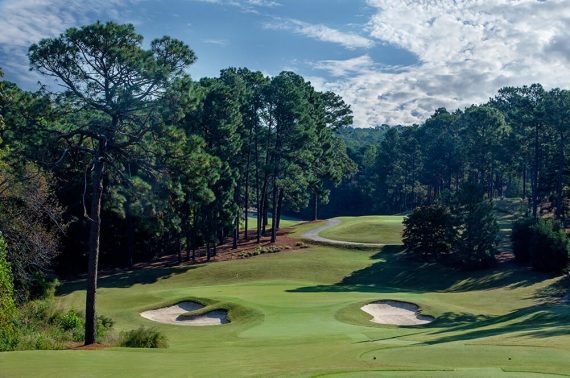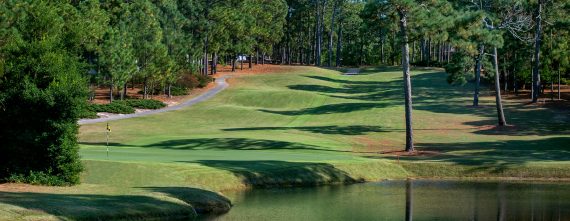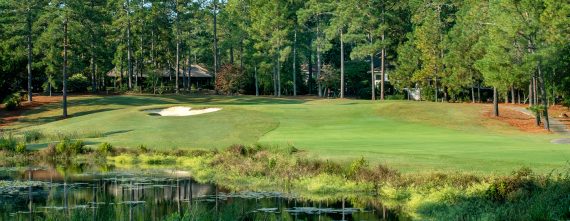Pinehurst No. 6 will be the fourth Pinehurst course to serve as a site for a USGA championship following the announcement of the USGA’s U.S. Adaptive Open Championship. We caught up with Pinehurst Resort’s Director of Golf Ben Bridgers and longtime Vice President of Course Maintenance Bob Farren to talk about Course No. 6, one of the true unsung heroes of stable of world-class courses. The course was originally designed by Tom Fazio and his uncle, George. Tom Fazio returned in 2005 for a major makeover, including new bunkers and faster greens.

16th Hole, Pinehurst No. 6
In your estimation, what role does course No. 6 play in the Pinehurst Resort rota?
Bridgers: No. 6 is a fantastic course layout for our members and resort guests. It’s certainly been a tournament-tested course as well, hosting the LPGA Tour qualifying school just a few years back, and with the announcement on Friday, Dec. 3, will be the first site of the USGA’s U.S. Adaptive Open Championship.
Farren: Pinehurst Course No. 6 is a very important component within our offering of experiences for our members and guests alike. The fact that it is a course away, though in close proximity, to our main campus is an opportunity to experience a wonderful Tom Fazio course in a different environment. The course is very popular with our members that live in the No.6 community offering a sense of pride and ownership.
What stands out to you about the course in terms of its architecture?
Bridgers: I really enjoy the use of the land and the routing of the golf course. There are great views, water hazards and uphill and downhill approach shots. Overall there is a lot of variety and playability.
Bob Farren: No. 6 is one of the few if not the last course that Tom Fazio co-designed with his uncle George Fazio in the late 1970s. The course has a balanced offering of challenging holes as well as birdie opportunities. No. 6 also has several holes with changes in elevation to add interest. Water comes into play on five holes.

13th Hole, Pinehurst No. 6
What stretch of holes stands out as particularly memorable or challenging?
Bridgers: The last four finishing holes have some great views and are challenging. The par-3 16th hole is a beautiful downhill shot. The 18th hole is a hard par to secure especially if you are in position to win an event.
Bob Farren: Holes 6 through 8 is a great stretch and offers and really good par-5 (No. 6) with water to the right of the green, followed by an outstanding par-3 along the lake. The 8th hole has some flavor of the Sandhills environment as a short par-4 with native areas along the right side.
Which hole presents the best birdie opportunity?
Bridgers: There are several birdie opportunities out there but the dogleg par-5 15th is probably the best. Normally a long iron into the green presents an easy opportunity to go low.
Bob Farren: I agree, the par-5 15th offers a chance to cut the dogleg with the danger of OB on the left or running out through the fairway on the right in order to set up a potential second shot onto the green.

10th Hole, Pinehurst No. 6
Which hole looms as a potential blow up hole? And what precautions can golfers take to play it safe on this hole?
Bridgers: The 10th hole is a short par-5 but has OB on the right and a hazard on the left as the fairway cuts in. I prefer to lay back with a hybrid or fairway wood to stay short.
Farren: Either the par-5 second hole or the par-5 15th can turn a potential birdie into worse if the risk doesn’t pay off.
Bottom line, why should golfers play Course No. 6?
Bridgers: The excellent course conditions have really made No. 6 into a premier style course. You get the Pinehurst feel with the wire grass and bunkering, but also the challenge of some uphill and downhill shots. The par-3s to me are so much fun to play and give you some great views.
Farren: Pinehurst No. 6 is simply a very good course with a good balance of holes that can be as challenging as you choose to make them through tee selection. From the tips it plays over 7,000 yards and to a slope of 139, so it’s no pushover.

